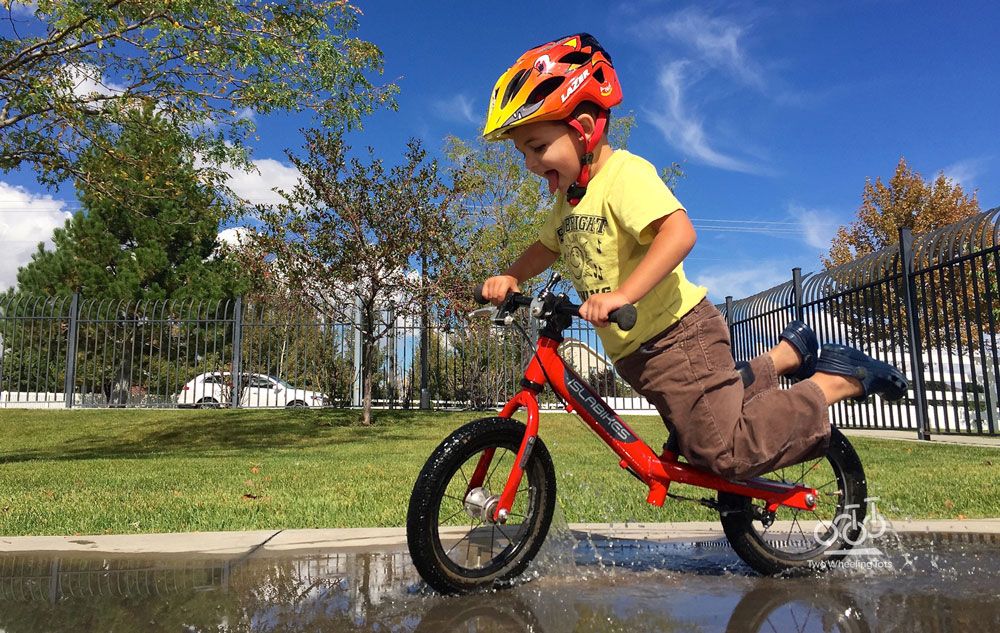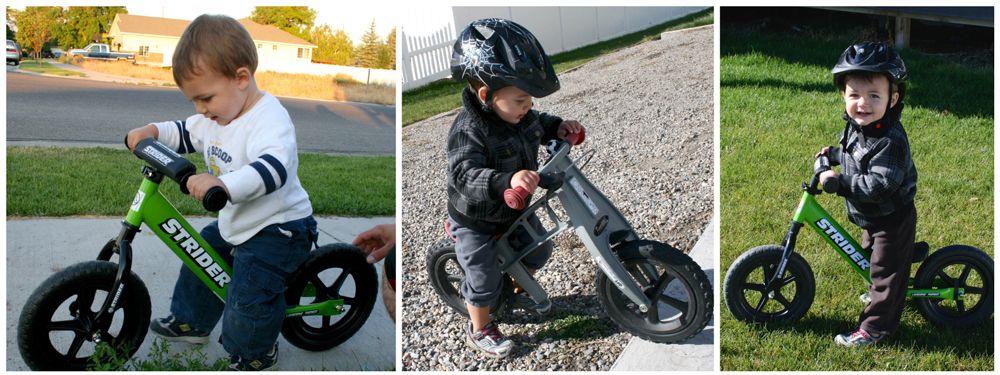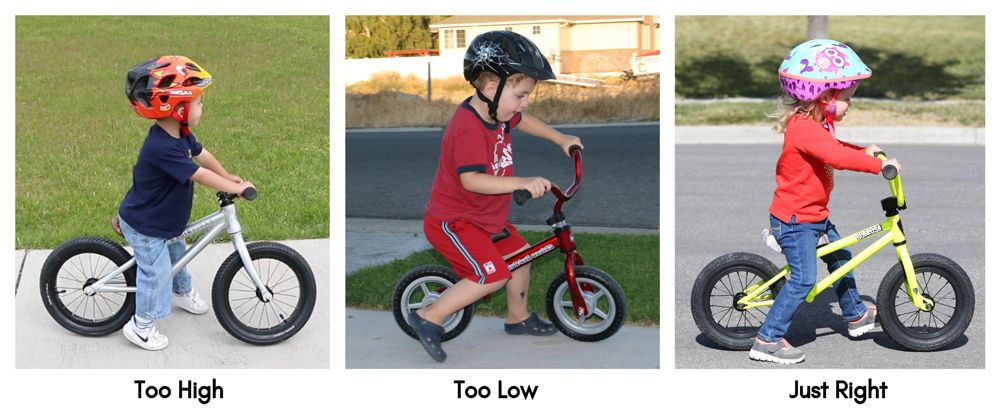An Easy Guide to Helping your Child Ride a Balance Bike
Look at that face! Oh the joy of mastering a balance bike! Your child can soon be balancing with the best of them – all that’s required of you is to provide time, a safe place to ride, and plenty of positive encouragement.
Little or no instruction is needed because for the most part, kids instinctively figure out how to use a balance bike by themselves. The advice below provides an outline of the natural process your child will go through in learning to ride a balance bike on their own.

Start with the Right Balance Bike
Before you can expect your child to master a balance bike, you need to set them up for success with the right bike! There are tons of balance bikes on the market these days, but you can see our top picks on our page: 12 Best Balance Bikes for Kids of All Ages
Here are a few of our favorites based on the age of your child when they begin riding:
| 2-Year-Olds | 3-Year-Olds | 4-Year-Olds |
| Guardian | Strider Sport | woom 1 Plus |
What are the Stages of Mastering a Balance Bike?
There are 4 steps most riders go through in learning to ride a balance bike.
- Stand and walk
- Sit and walk
- Sit, run, and balance
- Sit, run, and glide
1. Stand and Walk (Typically between 18 months to 3 years)

What your child will do: When first learning to explore a balance bike, kids ages 18 months to 3 years typically stand over the bike frame and walk the bike as their first step. They don’t even try to sit on the bike and often resist the suggestion to do so. Some kids will walk the bike around the whole block, while others will only walk it several feet.
How long will this stage last? The duration of this stage can vary greatly, but for almost all riders, it will be the longest learning stage. Some kids learn to sit and walk the bike during their first ride, while others can take months to get comfortable sitting down. The younger the child, the longer the standing and walking stage generally lasts.
What you can do to help: During this stage, and all stages really, it’s best to follow your child’s lead. Allow them to walk on the bike as long as they need to. For kids who are slow to progress, be sure to provide them plenty of opportunities to ride as well as limit or prevent their interaction with tricycles or pedal bikes with training wheels.
2. Sit and Walk (Typically between 2 to 3 years)

What your child will do: Eventually kids learn to sit on the balance bike’s seat, but once they do, they will still continue to walk the bike for a time. At this stage, the excitement for riding their bike tends to build as they begin to catch on to the idea of what a balance bike can do for them.
How long will this stage last? Like the “Stand and Walk” stage, the younger or more timid the child, the longer the “Sit and Walk” stage usually lasts. But once your child gets comfortable with sitting and moving at the same time, they realize that if they want to go fast, they have to run instead of walk. As a result, once sitting and walking is mastered, kids advance to the “Sit and Run” stage pretty quickly.
What you can do to help: During this stage, getting your child around other balance bike riders can be very beneficial. By watching other kids happily ride their bikes all around them, they will start to realize that bikes are really fun! Kids with competitive personalities also tend to try to keep up with other kids, which can help them transition to the “Sit and Run” stage.
Really timid riders, however, may become frustrated at how slow they are on the bike compared to others, and lose confidence in themselves. Like all things in parenting, try your best to determine if their personality will benefit from, or be hindered by, interaction with other balance bike riders.
3. Sit, Run and Balance (Typically between 2 and 4 years)

Parents: be prepared to get in shape! When your child learns to run on their balance bike, you better be ready to keep up with them because they quickly learn to run fast!
What your child will do: During this phase, kids learn to run on the bike and also master balancing. Most kids can figure it out on their own, but if they need some direction and don’t have the opportunity to be around other kids riding balance bikes, there are plenty of videos available on YouTube. Check out our own fun video showing our Baby Bike Tester rocking the pump tracks.
How long will this stage last? Stage 3 is the shortest stage – once kids learn to run, they easily advance to gliding as well. Adventurous kids quickly transition through this stage (sometimes within a day!), while timid kids could take a few weeks.
What you can do to help: Much more efficient than a tricycle or a bike with training wheels, kids are uninhibited on balance bikes and quickly learn they can go just about anywhere on their bike. As a result, it’s best to allow kids to practice in open areas where you don’t have to worry about them accidentally running into the street at the end of the block, or quickly rolling down the driveway into the street. Be sure to take the time to instruct them about where they are allowed to ride and where they are not.
4. Sit, Run, Glide and Explore (Typically between 2.5 and 4 years)

What your child will do: During the last stage of balance bike mastery, a child experiences the final and most exciting part of their ride – the glide! This comes as a natural step for most kids and they figure it out on their own.
In this final stage of balance bike riding, anything is possible because your child is now a master of their bike! From skateparks and bike jumps, to single-track trail riding and pump tracks, preschoolers can essentially go anywhere and do anything on a balance bike.
How long will this stage last? Many parents think that a balance bike is simply a means to an end – a tool to get their child to learn to ride a “real” bike. While this is partially true, the reality is that balance bikes are typically much more efficient, fit kids better, and are way more fun to ride than small pedal bikes (12” and 14”).
Don’t rush your kid – let them enjoy their balance bike until they express a desire to ride a pedal bike. They could be happily riding their balance bike for years!
What you can do to help: For those kids who may need guidance in learning the glide, having them roll down a driveway or a grassy hill can help them learn more quickly. And for exploring – take your kids on trails, buy small ramps, go to the bike park! Your child’s balance bike adventures will largely be determined by where you take them to ride.
Check out our directory of kid-friendly pump tracks and bike parks for places near you to take your child to practice their new skills.
How Does a Child Stop on a Balance Bike?
Stopping with Your Feet
Learning how to stop a fast moving bike is vital during the last two phases of balance bike riding. Kids by nature know to use their feet to stop. They usually use their whole foot to stop, using their heels with their feet in front of them.
However, some kids want to drag their toes to stop (with their feet behind them). While dragging their toes does help a child to stop, it usually does a number on their shoes. Encouraging them to stop with their feet flat on the ground will allow them to stop more quickly and extend the life of their shoes. Wearing open-toed shoes is not recommended as a result!

Stopping with Hand Brakes
Once kids have mastered balancing a bike, they are generally capable of using a hand brake, which allows them to stop faster and limits wear and tear on their shoes. Kids don’t have the hand/eye coordination to use a hand brake until 2.5 or 3 years old.
While not all balance bikes have hand brakes, if you live around hills, or if you know you have a speed demon on your hands, investing in a balance bike with a hand brake is a good idea.
The other advantage of a hand brake on a balance bike is that once a child learns to use the hand brake, they are better prepared to safely stop a pedal bike once they make that transition.
Some of our favorite balance bikes with hand brakes are the woom 1 and Guardian balance bike.
How Long Does it Take a Child to Learn to Ride a Balance Bike?
Balance bikes have a steeper learning curve than tricycles, scooters, or bikes with training wheels. As a result, parents and even kids often give up on balance bikes too quickly. Learning a balance bike can take time.
The time it takes depends largely on the child’s developmental stage and temperament. An eager, athletic 3-year-old may master the process within a week. A more timid older toddler may take months to master the ride.
If you start your child young, even the most athletic 18-month-old will probably take 9 months to a year to truly master his bike. The important thing to remember is that every kid is different and each stage of learning can be fun.
Kids Can Enjoy Balance Bikes for Years

How Do I Set Up a Balance Bike Properly?
Before you put your child on the bike, you need to set the seat height properly. To ride a balance bike, a child’s feet must be able to hit and push off of the ground while they are sitting comfortably on the bike.
A correctly fitted balance bike allows the seat height to be set about 1″ less than a child’s inseam (measured crotch to floor with shoes on) to allow an “athletic stance” with a slight knee bend.
Set the Seat Height Just Right for the Best Ride

We also recommend applying tire sealant to prevent flat tires if your balance bike has air tires.
What About Falling off a Balance Bike?
Toddlers and preschoolers generally always fall hands first. As a result, gloves can be a great investment when kids are starting off on a balance bike (Zippyrooz are a favorite of ours).
Generally, when kids do fall, they don’t fall very hard and typically don’t get hurt. As kids advance and become more adventurous on their bikes, they are more likely to get hurt during a fall.

There are two main reasons that balance bike falls don’t usually result in major injury:
- Balance bikes are lower to the ground so kids have less distance to fall than when falling off a bike with training wheels.
- Balance bikes don’t have any pedals or cranks arms for a child to fall on or come into contact with as they fall.
That said, a helmet is an absolute necessity when riding a balance bike. Our little ones have face planted on many occasions, and a helmet has made the difference between true injury and a minor set back.
Does My Child Need a Bike with a Footrest?
Many parents are often concerned about where a child should place their feet when gliding on a balance bike, and feel that a footrest is required. Ironically, in all the years we’ve been testing out balance bikes, we’ve never had a child ask where to put their feet when gliding.
Kids Can Glide With or Without a Footrest

Kids naturally raise up their feet when gliding and are not concerned about what to do with them. That being said, a well-designed footrest that does NOT impede a child’s stride certainly doesn’t hurt to have around, but also isn’t needed. If you’re set on having a footrest, we would recommend balance bikes by Strider.
Poorly Designed Footrests Interfere with a Child’s Stride

